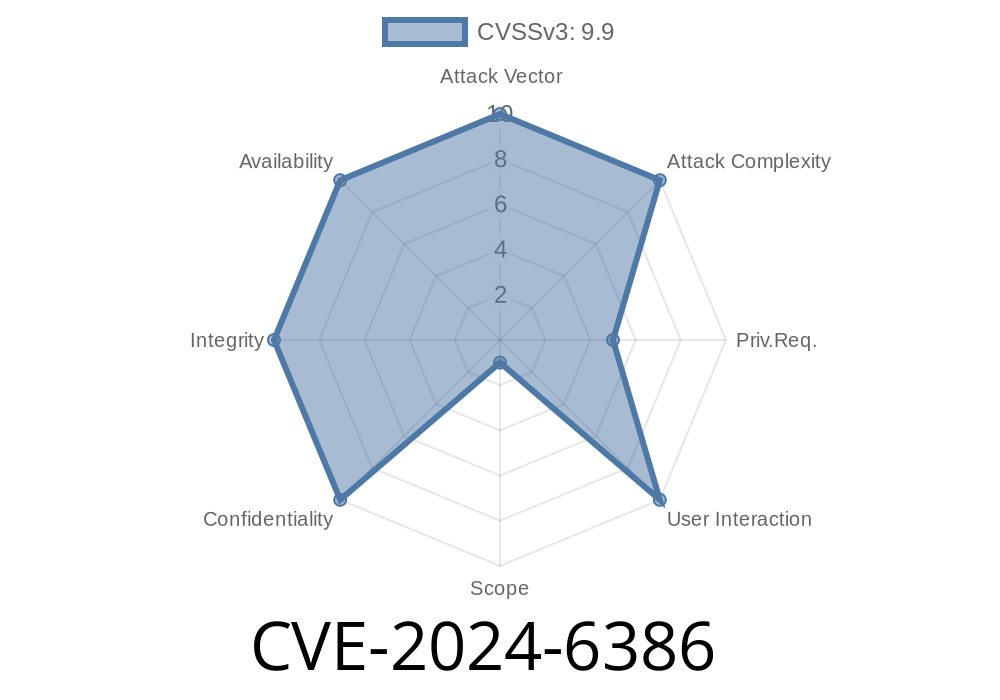The popular WordPress plugin WPML (WordPress Multilingual), which simplifies website translation and localization, has been found to contain a critical vulnerability that could lead to Remote Code Execution (RCE) on the server. This vulnerability, now designated as CVE-2024-6386, affects all versions up to and including 4.6.12 of the plugin.
In simple terms, this means that an attacker with Contributor-level access to a website or higher can potentially run arbitrary code on the server by exploiting this vulnerability, causing significant harm to the targeted website.
In this extensive post, we will discuss the technical details of this vulnerability, steps to reproduce the issue, and how it can be mitigated. We will also provide code snippets and links to original references for further understanding.
Details of CVE-2024-6386 Vulnerability
The root cause of this vulnerability lies in the improper input validation and sanitization of the 'render' function in the WPML plugin, which leverages the Twig Server-Side Template Injection. As a result, authenticated attackers with specific user roles can exploit this vulnerability and execute malicious code on the server.
Before diving into the code snippets and understanding how the vulnerability can be exploited, let us first understand the basics of Twig Server-Side Template Injection.
Twig is a modern templating engine for PHP, which provides a flexible and secure way to create templates used by web applications. The Server-Side Template Injection comes into the picture when user-supplied data is not properly sanitized or validated before incorporating it into the rendered template. In such cases, an attacker gains the ability to inject and execute arbitrary code on the server.
Now let's look at the vulnerable code in the WPML plugin
// Vulnerable 'render' function
function render($data, $template) {
$twig = new Twig_Environment(new Twig_Loader_Array());
return $twig->render($template, $data);
}
As seen in the above code snippet, the 'render' function accepts a data array and a template string as input, without proper input validation or sanitization, thus making the function susceptible to the Server-Side Template Injection vulnerability.
Exploiting the Vulnerability
An attacker, equipped with the knowledge of this vulnerability, can devise a plan to exploit it in the following ways:
Gain Contributor-level access or higher to the targeted WordPress site's dashboard.
2. Identify a feature or functionality in the WPML plugin that utilizes the vulnerable 'render' function.
3. Craft a malicious payload with Twig template syntax that contains arbitrary PHP code to be executed on the server.
Inject the malicious payload into the data array or template string passed to the 'render' function.
5. Trigger the vulnerability and wait for the malicious code to execute on the server, potentially causing severe damage to the affected site.
Mitigation Steps
As a website owner or administrator, you must take immediate action to protect your website from this critical security vulnerability. The following steps can help you mitigate the vulnerability and safeguard your site:
If updating is not feasible, consider disabling the plugin until an update can be safely applied.
3. Implement role-based access controls and limit the number of users with Contributor-level access or higher to minimize the attack surface.
4. Regularly monitor and review user activity, especially that of users with higher privileges, to detect any suspicious activities.
5. Apply strict input validation and sanitization measures on user-supplied data to mitigate Server-Side Template Injection attacks.
Conclusion
The critical vulnerability CVE-2024-6386 in the WPML plugin for WordPress poses a significant risk to website owners using the plugin in their sites. It is crucial to take immediate action and follow the mitigation steps outlined in this post to protect your website.
For more details on this vulnerability, you can refer to the original references
1. Original Advisory: Twig Server-Side Template Injection
2. WPML Changelog: Version 4.6.13, Security Update
3. CVE-2024-6386: National Vulnerability Database (NVD) Entry
Timeline
Published on: 08/21/2024 21:15:08 UTC
Last modified on: 08/22/2024 12:48:02 UTC
